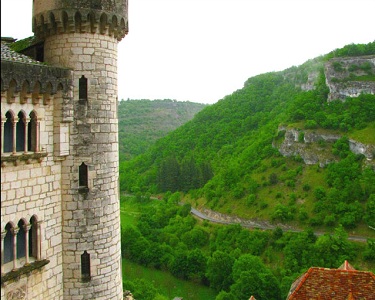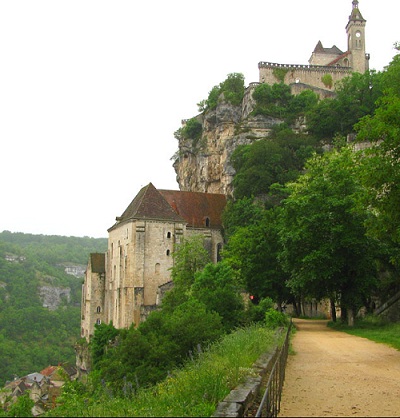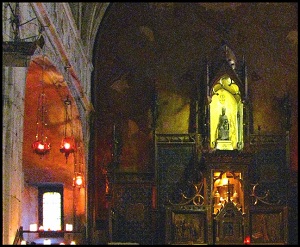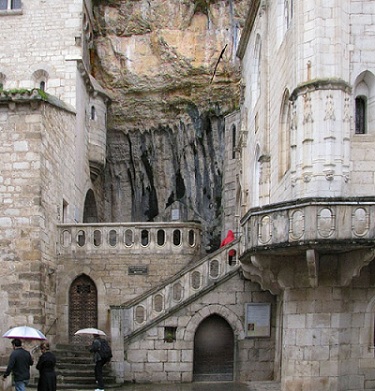
Inveterate cyclist Walter J. Moore, 70, takes a biking trip in the departments of Dordogne and Lot in southwest France and stops along the dramatic cliffs of Rocamadour to explore history and legends.
***
The view didn’t seem entirely real as I approached the sanctuaries of Rocamadour. Perhaps that’s because in addition to the natural drama of the way the sanctuaries are set into the cliffs above the Alzou River, Rocamadour has long stood in a shadowy zone between history and legend.
I’d been riding along the valley from the south. Between brief rain showers a spring sunrise illuminated the gray cliffs and the cité réligieuse. I thought that this combination of light, shadows, rocks, walls and mists would allow for exceptional photos for the Dordogne cycling guidebook I was preparing at the time.
The view of the cliff and the sanctuaries that hug it may have influenced a few movie set, including Raiders of the Lost Ark, but this is the real deal, and like much of history, what actually happened here seems more farfetched than fiction.
My own arrival was more like a scene from “Around the World in 80 days.” I’d flown in from Orlando two days before, taken public transportation from Charles de Gaulle Airport to the Paris Gare d’Austerlitz train station, had lunch next to the Jardin de Plantes, then taken the 4-hour train south to Brive la Gaillard. On arrival, I rented a micro van large enough to carry my luggage and bicycle, and off I drove to a small hotel in Souillac. The next morning, I rented a bike and took a first ride to Sarlat.
These cliffs facing south and some water from the Alzou, even though most of it is underground, is a lot like the area around the caves at Lascaux north of here. So Cro-Magnon, or even Neanderthal, groups could have lived here, plus Ice-Age bison and ibex. But what I would be seeing soon was more recent, 1,000 years old, though the legends date them back further.

And on up the valley I cycled.
Then came that slow (most are slow for me) climb up and through the two short tunnels to the castle level of Rocamadour.
From the top I could see the three levels of Rocamadour: the village at the base, the seven sanctuaries hugging the cliffs at the middle, and here at the top the medieval fortified castle that protected the pilgrims.
I locked my bike near the inclined elevator, stored my helmet inside the ticket kiosk with the cashier, and took the incline down to the village level. From there I would take the 216 steps of the Grand Staircase to the sanctuaries, with a few stories along the way.
The Roc part of Rocamadour refers to these rocks or cliffs. Amadour apparently comes from the hermit Amadour, who became St. Amadour.

Of the many versions of the identity of Amadour, my favorite is that he was actually Zacchaeus, the chief tax collector of Jericho, husband of Veronica, and that he once had Jesus as his houseguest. Zacchaeus and Veronica, disciples of Jesus, were eventually persecuted and driven out of Palestine. They followed the shore of the Mediterranean in a delicate skiff guided by an angel. After a journey halfway around the Mediterranean, they landed in southwestern Gaul, now southwestern France. There they met Martial, also a disciple of Jesus and spreading the Gospel in the region. The couple traveled to Rome and witnessed the martyrdoms of fellow saints Peter and Paul. After Veronica passed away, Zacchaeus returned to Gaul and constructed a chapel above the Alzou Valley. He lived in a cave as a hermit before he died.
There were a number of modern-day pilgrims ready to ascend the Grand Staircase. The group was quiet as the prepared to pass the Stations of the Cross indicated along the ascent.
Zacchaeus was buried next to the chapel he’d built. In the twelfth century, the nearby faithful started calling him St. Amadour, or Amator, though some say that the name refers to the fourth-century bishop Amatre of Auxerre. Whatever the case, in 1166 a body was uncovered near the very same chapel in such a remarkable state of preservation that people believed it could only be that of a saint.
In the Middle Ages, religious institutions thrived on possessing a piece a saint. During the twelfth century, every religious community across France wanted to give pilgrims a reason to stop for supplies, rest and exchange news. Much like drawing tourists, receiving pilgrims was good for the economy for that community. The major pilgrimage in Western Europe at the time was the journey to Santiago de Compostela in western Spain, site of the relics of St. James. Rich or poor, almost everyone that undertook a thousand mile pilgrimage had the means to complete it.
The discovery of St. Amadour’s well-preserved remains led to Rocamadour becoming a destination for pilgrims and a major stop on the route to Santiago de Compostela. The Rocamadour community prospered. But during the sixteenth-century Wars of Religion that pitted Protestants against Catholics, Protestants burned those remains, and an emboldened knight bashed the bones with a battleaxe. In spite of that desecration, there were remnants, and they are now in the St. Amadour Crypt below the Basilica of St. Sauveur.

It was now my turn to climb the Grand Staircase, passing along the way the faithful at the Stations of the Cross. Traditionally, pilgrims would climb the staircase on their knees, though few do so today.
Even on foot I needed to rest by the time I arrived at the sanctuary level. No rush; the chance to take in the view while recovering (rapidly, thanks to cycling) before going down into St. Amadour’s Crypt below Notre-Dame Chapel.
A sign stated that Bishop St. Martial had lived in the third century, further complicating the history of Rocamadour. Some say that the faithful were referring to St. Amator or bishop Amatre. There isn’t much hard data to go on. Relics of the day were currency with little or no authentication. And beatification was as messy as the Lehman bankruptcy or the Greek tax collection system.
I climbed up to the Notre-Dame Chapel.
Here in this dark church, also called Chapelle Miraculeuse, is the celebrated Vierge Noir (Black Madonna). Legend has it that Zacchaeus (St. Amadour) carved her from local black walnut. I read in Helen Martin’s guide to the area that the Black Virgin was greatly venerated in the Middle Ages, most fervently in the 12th century. Honored for her assistance in fertility and childbirth, she was an heir to pre-Christian views of a mother-god.

Coming out of the Chapel one sees a diagonal gash in the cliff face high above our heads. It’s a mark that legend says was left by Durandal, the sword of Roland.
Roland was a military leader fighting for Emperor Charlemagne in the eighth century. Roland is the subject of many legends in Europe and this how the France’s eleventh-century The Song of Roland puts it: Roland was retreating from a battle in Spain through the Pyrenees when his force was ambushed here by the Basques. The battle went against him. He had a horn named Oliphaunt that he then blew hoping for help from the Emperor. And he had a sword named Durandal. It was embedded with Christian relics and was considered to be unbreakable. With defeat imminent, Roland didn’t want Durandal to fall into the hands of the enemy. He tried to destroy it himself but as I said it was unbreakable. Finally, the Archangel Gabriel arrived. He took Durandal and threw it high and away. The sword struck the cliffs above the Alzou Valley, where it stays impaled to this day. The slash in the cliff to the left of the Chapel is where Durandal struck.
I followed a steep path back up to the ticket kiosk, recovered my helmet and bike, took a last photo, and set off for further adventures, including a bottle of Cahors vin noir in the evening.
– Text and photos © Walter Judson Moore, 2011.
Walter Judson Moore is the author of five cycling guidebooks to France and four companion queue sheets in print and as downloads. His guide “Dordogne Valleys and Villages” includes the area covered by this article. His work is available on Amazon and other online booksellers, as well as directly (and personally signed) from the author, who may be reached at wjmoore@tampabay.rr.com.
For further information on Rocamadour and the departments of Lot and Dordogne
Rocamadour Tourist Office
Lot Tourist Office (department includes Rocamadour and Cahors)
Dordogne Tourist Office (department includes Périgueux, Bergerac and Sarlat)
*Helen Martin’s Lot: Travels Through a Limestone Landscape in Southwest France. Moho Books, 2008 rev. ed.


This is a wonderful article. How fortunate to have someone who shares history, legend, cycling, and deep affection. I read the Song of Roland as a young girl–long before I could understand it–but I was caught by its magic. Next time I get to the Dordogne, I will look for Roland’s Durandal.
Thank you Elizabeth. The gash of Durandal has a chain hanging from it. To paraphrase a recent New York Times article, cycling is “your resume for adventure.”